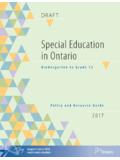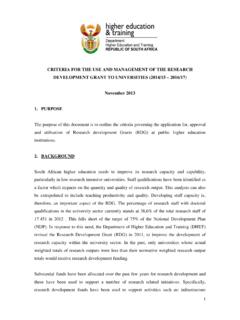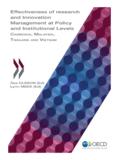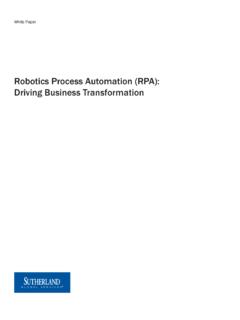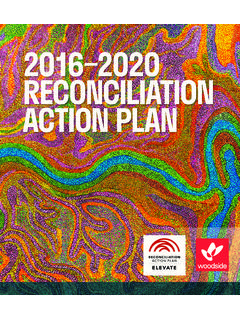Transcription of NORWAY - OECD.org
1 SCIENCE AND INNOVATION: NORWAYOECD SCIENCE, TECHNOLOGY AND INDUSTRY OUTLOOK 2012 OECD 2012356 NORWAYG eneral features of the STI system: NORWAY has oneof the world s highest incomes per capita, owing inpart to its rich and prudently managed naturalresources (hydrocarbons in particular) but also to ahighly productive economy, including businessservices. As noted in the OECD Reviews of InnovationPolicy: NORWAY , the country s productivityperformance indicates a level of innovation activityabove what the country s rather modest GERD( of GDP in 2010) would suggest. BERD ( )is below the OECD median (Panel 1(d)) butentrepreneurship indicators, notably venturecapital (1(h)), exceed this benchmark. Indicatorsrelated to the science base (1(a)(b)(c)) are around orslightly above the OECD median. NORWAY s RTA inenvironment-related technologies is strong andhas increased significantly over the past decade(Panel 3).
2 It is underspecialised in bio- and nano-technologies and ICT, despite some ICT infrastructure is very strong and near thetop of the OECD. Aspects of commercialisation,especially the filing of patents by universities andpublic labs, are moderate (1(p)). Recent changes in STI expenditures: R&Dexpenditures increased to USD billion in 2005 and 2010 GERD grew annually , and publicly financed R&D by ,indications of the resilience of the economy andgovernment s commitment to STI. In 2009, industryfunded 44% of GERD, government funded 47%, and8% was funded from abroad. Overall STI strategy: The White Paper on InnovationPolicy: An Innovative and Sustainable NORWAY aims toincrease innovation through creative people andundertakings. The White Paper on Research (2009-13)defines nine research policy goals (four horizontaland five thematic).
3 Strategies for green growth andfor biotechnology were presented in 2011; strategiesfor nanotechnology and ICT are to be completedin 2012. Ocean21 commenced in 2011 as acontinuation of the previous 21-strategies . Researchon the High North is also a long-term strategicpriority. The Research Council of NORWAY (RCN) alsodevelops research strategies, both thematic and foroverarching issues such as internationalisation policy governance: The Norwegian ministrieshave overall responsibility for financing R&D intheir sector. National priorities for research andinnovation are formulated at government level. Asthe only research council in NORWAY , RCN isessential to the development and implementationof research and innovation policy and ensures co-ordination of research-related issues from basicresearch to innovation.
4 RCN was reorganised as of1 January 2011. Innovation NORWAY funds businessinnovation and regional development. It is nowowned by the Norwegian Ministry of Trade andIndustry (51%) and country authorities (49% on anequal basis). SIVA, the Industrial DevelopmentCorporation of NORWAY , provides practicalHot STI issues Continuing economic diversification, building on the resource base and other strengths. Focusing on global challenges and green growth. Fostering innovation in services, including public services. Strengthening internationalisation and the attractiveness of NORWAY as a location for figuresLabour productivity, GDP per hour worked in USD, , as % of GDP, (annual growth rate, 2005-10 )( ) (annual growth rate, 2005-10)(+ )Environmental productivity, GDP per unit of CO2 emitted in USD, publicly financed, as % of GDP, (annual growth rate, 2005-09)(+ ) (annual growth rate, 2005-09)(+ ) SCIENCE AND INNOVATION: NORWAYOECD SCIENCE, TECHNOLOGY AND INDUSTRY OUTLOOK 2012 OECD 2012357 Figure and innovation in NorwayNote:Normalised index of performance relative to the median values in the OECD area (Index median = 100).
5 050100150200100020015050 Public R&D expenditure (per GDP) (a) Top 500 universities (per GDP) (b) Publications in the top-quartile journals (per GDP) (c)Fixed broadband suscribers (per population) (k) Wireless broadband suscribers (per population) (l) Networks (autonomous systems) (per population) (m) E-government readiness index (n) Industry-financed public R&D expenditures (per GDP) (o) Patents filed by universities and public labs (per GDP) (p) International co-authorship (%) (q) International co-patenting (%) (r) Adult population at tertiary education level (%) (s) 15-year-old top performers in science (%) (t) Doctoral graduation rate in science and engineering (u) S&T occupations in total employment (%) (v)Business R&D expenditure (per GDP) (d) Top 500 corporate R&D investors (per GDP) (e) Triadic patent families (per GDP) (f) Trademarks (per GDP) (g) Venture capital (per GDP) (h) Patenting firms less than 5 years old (per GDP) (i) Ease of entrepreneurship index (j)Top halfOECD Bottom halfOECD Science baseBusiness R&D and innovationEntrepreneurshipPanel 1.
6 Comparative performance of national science and innovation systems, 2011a. Competences and capacity to innovateTop/bottom 5 OECD valuesMiddle range of OECD valuesOECD medianNorwayb. Interactions and human resources for innovationKnowledge flows andcommercialisation Internet for innovationHuman resourcesTop halfOECD Bottom halfOECD SCIENCE AND INNOVATION: NORWAYOECD SCIENCE, TECHNOLOGY AND INDUSTRY OUTLOOK 2012 OECD 2012358information and infrastructure services forinnovation; it has part-ownership of science andresearch parks. The Norwegian Design Councilpromotes the use of design as a strategic tool forinnovation. Innovation NORWAY and SIVA underwent a comprehensive evaluation in 2010. Anevaluation of RCN is under way and expected to becompleted in base: The public sector is a major researchperformer in NORWAY .
7 HERD is of GDP andGOVERD is of GDP. The government decidedto discontinue the Research Fund from thebeginning of 2012 as interest rate fluctuationsundermined stable funding. It will be replaced byregular funding through the national and indicator-based allocationmechanisms are used in all branches of the publicresearch system, including higher educationinstitutions, to which 30% of the funds areallocated, research institutes and health R&D and innovation: A relatively large shareof BERD is performed by SMEs (Panel 2). TheSkattefunn tax credit scheme is the single largestR&D support scheme for business, with an expectedtax expenditure of USD135 million for 2012. Themain programme for R&D grants to businesses, BIA,is an open research arena in which firms compete onproject quality without thematic restrictions.
8 Sector-oriented and specific technology programmes arealso in place. Special importance is given to has been some shift from indirect to directsupport for business R&D and innovation (Panel 4).Entrepreneurship: There are several specificprogrammes for seed capital: Argentum, a fund-of-funds invests in VC and private equity funds fromstart-ups to buyouts. The investment firmInvestinor AS invests equity directly in companiesin the start-up and later-stage venture phase. Forseed capital funds, state capital is provided as loanswith a risk relief element. Clusters and regional policies: Regional R&D andinnovation are promoted in clusters via programmessuch as the VRI and ARENA programmes as well asin centres of expertise (NCE), and are also financedby dedicated regional funds for R& flows and commercialisation: Severalinstruments foster knowledge flows, includingcentres of excellence (SFF), centres for research-based innovation (SFI) and centres forenvironment-friendly energy research (FME).
9 Inaddition, the Industrial and Public Sector R&DContract Programmes (IFU/OFU) stimulateinnovative development co-operation. The FORNY2020 programme and technology transfer officespromote commercialisation. A White Paper onintellectual property is expected in : Internationalisation is an overallpriority of the government s research andinnovation policy. In 2010, RCN adopted a newinternationalisation strategy under which all RCNactivities must include clearly defined objectivesand plans for international co-operation. In termsof funding, there is a shift from instrumentsdedicated to internationalisation towards includingthe internationalisation dimension in all actively promotes participation inEuropean R&D resources: NORWAY has a high share of theadult population with tertiary education (1(s)) and ahigh share of S&T occupations in total employment(1(v)).
10 The Action Plan for Entrepreneurship inEducation 2009-14 aims to strengthen students personal skills, perspectives, creativity andinnovative thinking. The Science for the FutureStrategy 2010-14 promotes mathematics, scienceand technology. Career guidance and information ispromoted via regional partnerships and technologies: Green growth andenvironmental issues continue to develop as keyareas for STI, alongside prioritised technologyfields such as bio- and nano-technology, and innovation: The Strategy for Green Growthsupports green technology with a dedicatedprogramme of USD 52 million (2011-13), includingfor offshore wind production facilities and greentransport models. New centres for environment-friendly energy research (FME) have beenestablished as has a new centre for climateresearch (Bjerknes Centre for Climate Dynamics).










